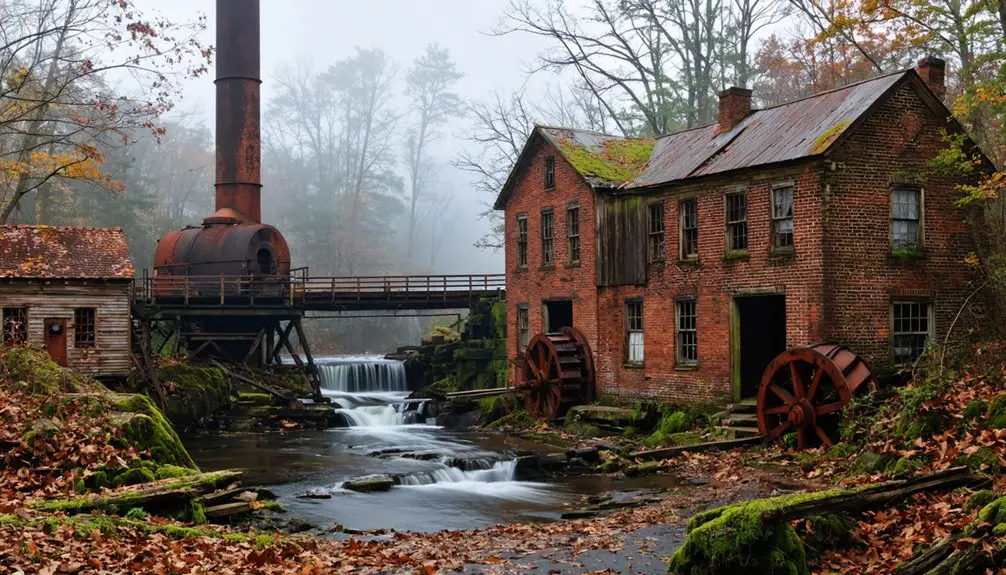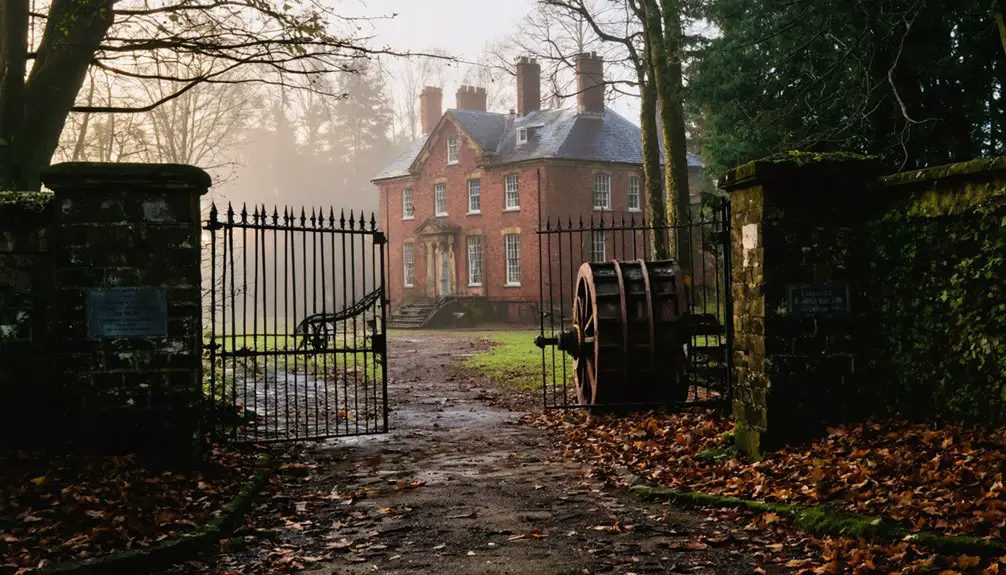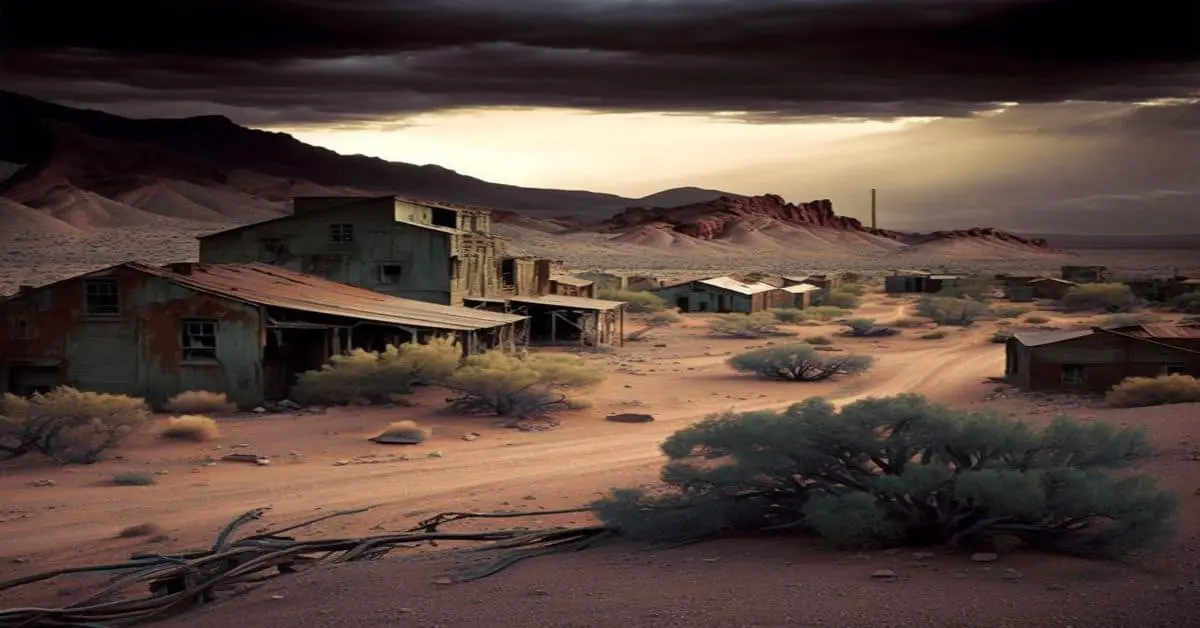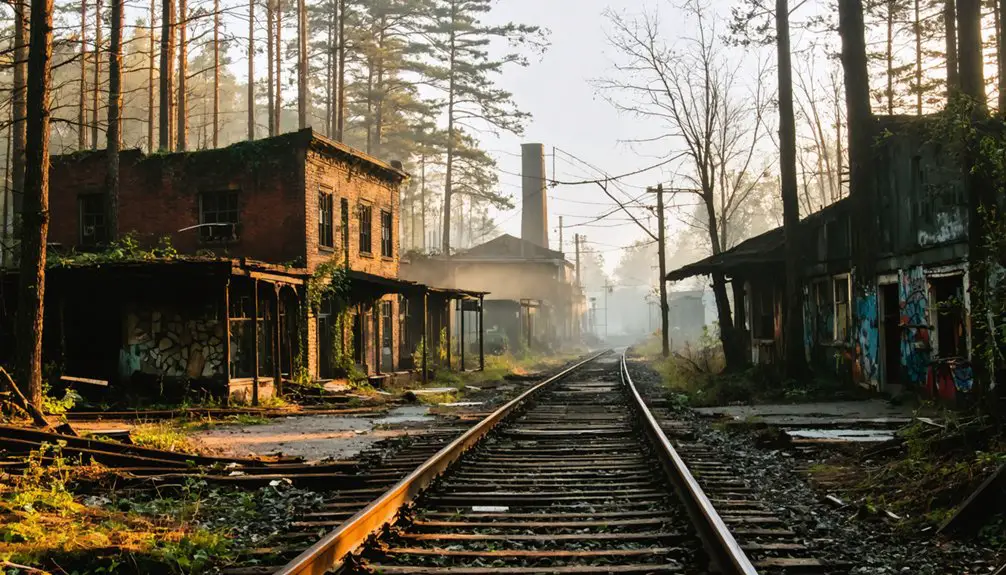You’ll discover Batsto Village, an 18th-century industrial powerhouse turned ghost town, nestled within New Jersey’s Wharton State Forest. Founded in 1766, this well-preserved settlement once thrived on iron and glass manufacturing, serving as an essential military supplier during the American Revolution. Today, you can explore over 40 original structures, including the 50-room Batsto Mansion and America’s oldest operating post office. Each building holds centuries of fascinating stories waiting to be uncovered.
Key Takeaways
- Batsto Village, established in 1766, is a preserved historic site in New Jersey that showcases an abandoned industrial community from the colonial era.
- The village transitioned from iron production to glassworks before declining in 1867, leading to its eventual abandonment as an industrial center.
- Over forty original structures remain preserved, including the 50-room Batsto Mansion, showcasing 18th and 19th-century architectural styles.
- New Jersey State purchased and restored Batsto Village between 1954-1958, transforming it from an abandoned town into a cultural heritage site.
- The village maintains its historic post office without a ZIP code and features reported paranormal activity, including sightings of the “Water Wizard.”
The Birth of an Iron Empire
While countless colonial enterprises emerged in the late 18th century, Batsto Village‘s establishment in 1766 by Charles Read marked the birth of a significant industrial powerhouse.
Amidst colonial America’s industrial rise, Batsto Village emerged as a powerhouse of innovation under Charles Read’s visionary leadership.
You’ll find that Read’s industrial innovation centered on three essential resources: the Batsto River’s water power, dense forests for charcoal production, and rich deposits of bog iron ore harvested from local swamps. Workers transported the iron ore aboard shallow boats called shallops to the village’s blast furnace.
When John Cox took control, he transformed Batsto into a key wartime supplier. In 1784, William Richards purchased the village and began developing it into a self-sustaining community.
You’re witnessing community resilience at its finest – the village’s remote location shielded it from British attacks, allowing uninterrupted production of important military supplies like cannons and camp kettles.
The Continental Army recognized the ironworkers’ critical role by exempting them from military service, ensuring America’s revolutionary forces maintained their supply of vital iron products.
Revolutionary War Legacy
As the American Revolution unfolded, Batsto Village emerged as a vital military supplier, defying British restrictions to produce essential weaponry and equipment for the Continental Army. The village’s Revolutionary significance was so profound that its workers received military draft exemptions to maintain production of cannons, cannonballs, and camp kettles.
Under John Cox’s ownership, Batsto’s military contributions expanded dramatically. You’ll find evidence of the village’s strategic importance in its construction of a defensive fort and its role in thwarting planned British attacks. Unfavorable winds prevented the British from executing their planned ambush of the village. Their camp equipment supplies were crucial, as Batsto manufactured essential items like kettles and wagon fittings for Continental Army forces.
Even George Washington himself commissioned personalized firebacks from the ironworks. The operation, powered by local bog iron ore, sustained regional supply chains throughout the war, though production declined after 1783 when William Richards acquired the property and transformed it into a self-sustaining village.
Life in a Company Town
Beyond its military significance, Batsto Village flourished as a quintessential American company town during the late 18th and early 19th centuries.
The worker dynamics revolved around a controlled economic system where you’d receive company scrip for your labor, redeemable only at Batsto’s general store. You’d find yourself living in a modest two-story home, part of a planned settlement that fostered community cohesion through shared facilities and proximity to your workplace. In the 1840s, the village underwent significant change when it transitioned from iron production to glassworks operations. After Joseph Wharton purchased the village in 1876, he implemented major improvements to modernize the infrastructure.
While the Richards family mansion overlooked the village from above, you’d experience a structured social hierarchy typical of company towns. Your daily life would intertwine with both industrial and agricultural pursuits, from iron production to farming.
The remote location meant you’d rely heavily on Batsto’s self-sufficient infrastructure, including its gristmill, blacksmith shop, and post office.
The Wharton Era Transformation
Joseph Wharton’s purchase of Batsto Village in 1876 marked a dramatic shift from iron manufacturing to agricultural innovation, as he’d envisioned transforming the 96,000-acre property into a sustainable farming enterprise.
You’ll find evidence of his experimental approach in the construction of an underground silo and establishment of cranberry bogs, showcasing his commitment to agricultural testing and development. The operation included a bustling sawmill and forestry business that continued until his death in 1909.
Beyond the economic transformation, Wharton’s renovation and expansion of the mansion reflected his dual focus on creating both a productive agricultural estate and a refined family retreat.
Industrial Vision and Investments
Following his acquisition of Batsto Village and its surrounding 96,000 acres in 1876, industrialist Joseph Wharton orchestrated a dramatic transformation of the declining manufacturing hub into an agricultural powerhouse.
Wharton’s industrial investments reflected his forward-thinking agricultural vision. You’ll find his strategic approach in the construction of new infrastructure, including a sawmill and an underground silo, which supported his shift toward sustainable resource management.
He cleared vast tracts for cranberry cultivation while maintaining forest products operations, demonstrating his commitment to diversified land use. The Batsto Mansion’s renovation into a family retreat symbolized the property’s evolution from industrial center to agricultural estate.
While iron and glass production ceased, Wharton’s investments in farming, milling, and forest management preserved the village’s economic viability for future generations.
Agricultural Testing Programs
While Batsto Village had long integrated industrial and agricultural activities, the site’s transformation under Wharton’s ownership ushered in an era of scientific agricultural experimentation.
You’ll find that extensive soil testing programs emerged to analyze the unique Pine Barrens conditions, enabling researchers to identify ideal crop varieties for the region’s sandy, acidic terrain.
The testing programs, conducted in partnership with Rutgers University’s Agricultural Experiment Station, introduced sustainable practices that revolutionized local farming. The station’s research-based education initiatives helped local farmers adapt and implement new agricultural techniques.
Scientists evaluated irrigation systems, monitored water quality through test wells, and developed innovative crop selection protocols.
They’d also successfully integrate fishery restoration projects with agricultural water management, establishing a model for ecosystem-based farming.
This all-encompassing approach to agricultural testing created lasting impacts, informing modern conservation techniques specifically adapted to the Pine Barrens environment.
Mansion Renovation Projects
In the late 19th century, an extensive $40,000 renovation transformed the Batsto Mansion from a modest Richards family house into an elegant Italianate masterpiece.
Joseph Wharton’s ambitious vision expanded the mansion to 32 rooms while incorporating Victorian-era mansion aesthetics and modern amenities like running water from a 12,000-gallon tank fed by Batsto Lake.
The renovation challenges included installing gas lines within the walls for future infrastructure that never materialized.
The mansion’s unique decorative iron stars were installed to conceal earthquake rods during renovations.
You’ll find original furnishings throughout the 14 public rooms, including Wharton’s dining table and secretary desk.
The project seamlessly merged functionality with elegance, as Wharton intended the mansion to serve both as a gentleman’s retreat and a management hub for his agricultural enterprises.
Today, you can explore this preserved tribute to Wharton’s architectural legacy through year-round tours.
Haunting Tales and Local Legends
Throughout Batsto Village‘s rich history, supernatural tales and local legends have woven themselves deeply into the fabric of this historic settlement.
You’ll discover the ghostly encounters of Frank Peck, the mysterious “Water Wizard,” and hear whispers of the Richards family’s spirits lingering near the old ironworks.
Native American presence echoes through tales of Indian Ann, whose basket-weaving legacy adds mystical depth to the village’s spiritual landscape.
- Visit the Indian Mills and Tabernacle areas, where the Water Wizard’s presence is still felt
- Explore the haunted Richards mansion, where unexplained phenomena connect to the ironworks’ end in 1848
- Walk through the old cemetery in Tabernacle, home to legendary figures and their restless spirits
- Discover the general store and post office, where tales of company workers’ spirits persist
Industrial Rise and Fall

You’ll find Batsto Village’s industrial story centered around its prosperous ironworks, which produced essential military supplies during the Revolutionary War and continued strong production into the early 1800s under the Richards family’s management.
When New Jersey’s iron industry collapsed in the 1840s, Batsto attempted to reinvent itself through glass manufacturing, utilizing the area’s abundant natural resources.
The glass venture proved unsuccessful, ultimately closing in 1867 and marking the end of Batsto’s industrial prominence.
Iron Manufacturing Era
While Charles Read established Batsto Village in 1766, the settlement rapidly evolved into a prominent iron manufacturing hub during America’s colonial and early republic periods.
Using local bog iron mining and water-powered techniques, Batsto’s iron production techniques became crucial to America’s independence, supplying the Continental Army with essential munitions and equipment.
You’ll discover how Batsto’s industrial might rested on four key foundations:
- Strategic use of bog iron ore harvested from nearby swamps
- Onsite charcoal production from local hardwood forests
- Water-powered cold blast furnaces and forges along Batsto River
- Self-sufficient manufacturing of products from raw materials to finished goods
The village’s iron works thrived through revolutionary times, producing everything from military supplies to household implements, establishing Batsto as New Jersey’s premier iron manufacturing center.
Glass Production Transition
As Batsto’s iron manufacturing declined in the 1840s, Jesse and Thomas Richards transformed the village’s industrial foundation by establishing a new glassworks operation in 1846.
You’ll find that their seven-building facility specialized in producing window panes and street lamp glass, serving both local needs and wider markets during this industrial shift.
While the glass production venture initially sustained the village’s economy, maintaining employment for workers who continued living in the early 1800s housing, its success proved relatively short-lived.
In the 1860s, devastating fires destroyed most of the manufacturing facilities, leading to the operation’s permanent closure in 1867.
Joseph Wharton later acquired the property, shifting its focus from industry to agriculture and water resources, marking the end of Batsto’s industrial era.
Architectural Heritage
Since its establishment in 1766, Batsto Village’s architectural heritage reflects a remarkable blend of 18th-century industrial pragmatism and 19th-century Victorian elegance.
The village’s architectural styles evolved from utilitarian industrial structures to include sophisticated residential buildings, showcasing the transformation of this historic New Jersey settlement.
You’ll discover these distinctive features throughout the village:
- The 50-room Batsto Mansion, featuring Victorian ornamentation and a striking tower
- Industrial buildings constructed with locally-sourced materials, including brick, timber, and iron
- Worker housing and auxiliary structures that formed a self-sustaining community
- The 1808 Methodist Episcopal Church, representing early American religious architecture
Historic preservation efforts since the 1950s have maintained over forty original structures, ensuring you can experience authentic 18th and 19th-century architectural craftsmanship firsthand.
Preserving a Historic Treasure
You’ll find Batsto Village’s preservation story woven through decades of dedicated restoration efforts by the Batsto Citizens Committee and state partnerships, protecting everything from the mansion’s original woodwork to the village’s industrial structures.
Through monthly donations and volunteer craftsmen’s expertise, the village maintains its authentic 18th and 19th-century architectural features while safeguarding against modern environmental threats.
The site’s educational programs, including guided mansion tours and hands-on demonstrations across 18 historic buildings, connect you directly to southern New Jersey’s rich industrial and cultural heritage.
Restoration Efforts Over Time
Following New Jersey State’s purchase of Batsto Village and the surrounding 96,000-acre Wharton property between 1954-1958, extensive restoration efforts transformed this historic industrial settlement into one of the state’s most visited cultural sites.
The restoration timeline began with the 50-room Batsto Mansion and dam reconstruction, leading to the village’s formal dedication in 1961.
You’ll discover these key preservation milestones:
- A visitor center established in 1961 featuring museum exhibits and educational programs
- Original industrial structures preserved as demonstration sites, including the sawmill and charcoal kiln
- Infrastructure rebuilt to support both preservation and public access
- Agricultural elements maintained to reflect Joseph Wharton’s legacy of integrated land use
The restoration continues to balance historic authenticity with sustainable public engagement within the Pinelands National Reserve framework.
Protecting Original Architecture
Through rigorous legal protections and preservation mandates, Batsto Village maintains its architectural integrity as a protected historic treasure within both the New Jersey and National Register of Historic Places.
You’ll find stringent regulations governing any alterations to the village’s 18th and 19th-century structures, ensuring historical authenticity is preserved for future generations.
The village’s preservation strategy employs period-appropriate techniques and materials, from hand-hewn wood to traditional masonry.
Experts regularly inspect and repair the 50-room mansion and surrounding buildings using conservation methods that protect original features.
When you visit, you’ll notice how carefully managed public access helps minimize wear on fragile architectural elements.
The state’s purchase of Batsto in the 1950s established a foundation of institutional support, enabling ongoing preservation through grants, donations, and visitor fees.
Educational Programs Today
While preserving Batsto Village’s historic architecture remains paramount, the site’s educational initiatives bring its rich heritage to life for modern visitors.
Through diverse community programs and interactive workshops, you’ll discover the rich tapestry of Pine Barrens history and ecology. The site’s all-encompassing educational approach combines hands-on experiences with expert interpretation, ensuring deep engagement with both natural and cultural heritage.
- Participate in seasonal field trips, including kayaking on Batsto Lake and guided hikes along historic trails
- Learn traditional crafts from Lenape Nation artisans, including pine needle basketry
- Explore the child-friendly museum space and age-appropriate presentations
- Engage in conservation workshops focusing on Pinelands ecosystem management and wildlife preservation
These programs connect you directly to Batsto’s past while fostering environmental stewardship for its future.
Natural Wonders and Scenic Beauty
Located within Wharton State Forest, Batsto Village offers visitors a stunning array of natural wonders, from the meandering Mullica River to the expansive Batsto Lake.
You’ll discover well-maintained scenic trails, including a section of the Batona Trail, that wind through pine forests and alongside tranquil waters.
The diverse ecosystem supports unique wildlife observation opportunities throughout the seasons. You can spot turtles basking on logs in quiet ponds, watch native birds soar overhead, and examine rare plant species adapted to the Pine Barrens’ acidic soil.
The landscape transforms dramatically with each season, from spring blooms to autumn’s rich colors.
Whether you’re hiking through shaded pathways, canoeing on Batsto Lake, or photographing historic waterworks against natural backdrops, you’ll find countless ways to experience this preserved wilderness.
Tales From the Post Office Time Capsule
Since its establishment in 1852 by ironmaster Jesse Richards, the Batsto Post Office has served as a remarkable time capsule of 19th-century postal operations.
Step back in time at the Batsto Post Office, where 19th-century postal traditions remain untouched since ironmaster Jesse Richards opened its doors.
You’ll find this unique facility still functioning without a ZIP code, preserving authentic postal artifacts through its rare hand-cancellation practices. The post office’s story weaves through community narratives of industrial rise, decline, and preservation.
- Your mail receives one of only four authorized manual cancellations in the United States
- You’re experiencing a living museum that’s operated from the same stone building since the 1800s
- You’ll witness postal operations exactly as they functioned during Batsto’s industrial heyday
- Your letters become collectible pieces of history through the post office’s distinctive handling process
The preservation efforts of the 1960s guarantee you can still participate in this authentic slice of American postal history.
Frequently Asked Questions
Can Visitors Stay Overnight in Any of the Historic Buildings?
You won’t find overnight accommodations within any historic buildings, as they’re protected for historic preservation purposes. You’ll need to book lodging at nearby hotels or rentals outside the village.
What Items Were Manufactured From the Glass Produced at Batsto?
You’ll find that glass production focused primarily on window glass and street lamp components, with architectural glass and various bottles also having historical significance in Batsto’s manufacturing legacy.
Are There Guided Tours Available During Winter Months?
As crisp as winter frost, you’ll find guided tours running through December and January. Your winter activities include 2 p.m. tour schedules, with special holiday mansion tours in mid-December.
Did Native Americans Have Permanent Settlements in the Batsto Area?
You’ll find that Native American settlement history shows no permanent villages at this location – only temporary hunting camps and seasonal sites from 5000 BC through 1200 AD.
How Many Workers Lived in Batsto During Its Peak Production Years?
While exact worker population and production statistics aren’t documented, you’ll find historical evidence suggesting dozens to possibly over 100 workers with their families resided there during peak ironworking operations.
References
- https://www.paranormalghostsociety.org/Batsto.asp
- https://en.wikipedia.org/wiki/Batsto_Village
- https://www.atlasobscura.com/places/batsto-village
- https://www.youtube.com/watch?v=36vSMghKUyw
- https://batstovillage.org/history/
- https://njhistoryandsites.org/2024/01/14/historic-batsto-village-in-hammonton-nj/
- https://nj.gov/dep/parksandforests/historic/docs/Batsto_11 x 17_web.pdf
- https://philadelphiaencyclopedia.org/essays/iron-production/
- https://dep.nj.gov/earthday/timeline/m1985/
- https://thedigestonline.com/new-jersey/batsto-village/



